This DIY leave-in conditioner is made with all-natural hair nourishers, like bamboo, marshmallow root, and honeyquat to moisturize and fortify strands. It’s also oil-free (save for a few drops of essential oil), so it won’t weigh down your hair down. Spritz on hair before heat-styling for added protection or right before bed for a moisture boost.
It works great in hot, humid weather, too—just comb it through freshly washed hair to tame summer frizz.

If there’s one thing I’ve learned from my hairdresser over the years, it’s that there’s no such thing as too much conditioner. Yes, even if your hair is fine, oily, or flat.
Conditioner is a must for keeping frizz and split ends away, no matter what kind of hair you have. But especially if you have hair bugaboos, a leave-in conditioner may be just what you need to amp up your hair’s health with minimal effort.
Jump to:
- Benefits of Homemade Leave-In Conditioner
- Ingredients
- How to Make Leave-In Conditioner
- Substitutions
- Essential Oils for Leave-In Conditioner
- Leave-in Conditioner Recipe Variations
- For Dry Hair: Coconut Milk and Aloe Vera Leave-In Conditioner
- For Curly Hair: Argan and Shea Butter Leave-In Conditioner Recipe
- For Oily Hair: Green Tea and Honey Leave-In Conditioner
- For Normal Hair: Rosewater and Glycerin Leave-In Conditioner
- For Fine Hair: Apple Cider Vinegar and Water Leave-In Conditioner
- For Frizzy Hair: Smoothing Argan Oil and Honey Leave-In Conditioner
- For Thinning Hair: Volumizing Rice Water and Lavender Leave-In Conditioner
- Storage
- Using Homemade Leave-In Conditioner
- FAQ
Benefits of Homemade Leave-In Conditioner
Using a homemade leave-in conditioner can help improve the look and feel of your hair, making it easier to manage and style while also providing long-term benefits for hair health. Here’s how:
Moisture retention
Leave-in conditioners are designed to hydrate and moisturize your hair throughout the day, keeping it soft and manageable. This is especially beneficial for dry or damaged hair, as it helps to restore moisture and improve overall hair health.
Detangling
Leave-in conditioners contain ingredients that help to detangle hair, making it easier to comb through and style. This can reduce breakage and damage caused by tugging and pulling on knots and tangles.
Heat protection
Many leave-in conditioners contain ingredients that provide heat protection, forming a barrier between your hair and styling tools such as blow dryers, straighteners, and curling irons. This can help prevent heat damage and keep your hair looking healthy.
Frizz control
Leave-in conditioners can help to tame frizz and flyaways, leaving your hair looking smooth and polished. They can also help to seal the hair cuticle, reducing the amount of moisture that can penetrate the hair shaft and cause frizz.
Enhanced shine
Leave-in conditioners often contain ingredients that add shine to your hair, making it look healthier and more vibrant.
Ingredients
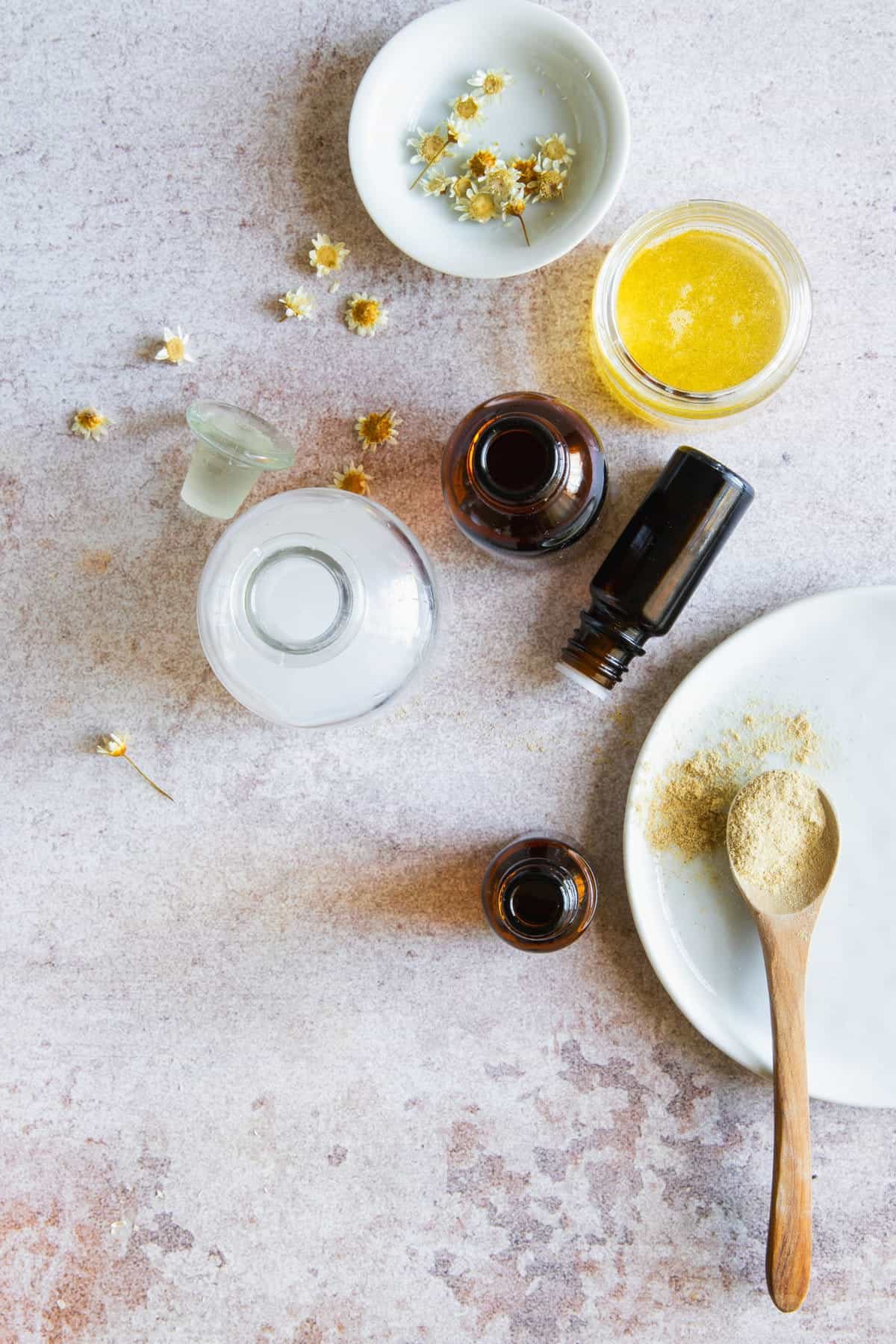
When combined, these natural ingredients for leave-in conditioner create a nourishing spray that moisturizes, detangles, strengthens, and adds shine while also providing some aromatic benefits.
Marshmallow Root: Contains mucilage, a gel-like substance that helps to detangle and condition hair. It also provides “slip,” making it easier to comb through and style hair.
Bamboo Extract: Rich in silica, bamboo extract helps to strengthen hair, promote elasticity, and add shine. It can also help to improve the overall health of the hair and scalp.
Honeyquat: Derived from honey, honeyquat is a conditioning agent that helps to moisturize and soften the hair. It also adds shine and improves manageability.
Chamomile Essential Oil: Chamomile essential oil has a pleasant aroma and is often used in hair care products for its balancing and soothing properties.
Preservative: Essential for preventing the growth of bacteria, mold, and other microbes in the water-based spray. Without a preservative, water-based products can quickly spoil and become unsafe to use.
See recipe card for measurements.
How to Make Leave-In Conditioner
Step 1: Infuse the marshmallow root

In a glass jar or bowl, combine the distilled water and marshmallow root powder. Stir well. Allow the mixture to infuse overnight, then strain out the marshmallow root using a fine mesh strainer or cheesecloth.
There may still be some marshmallow root powder in your infusion—that’s okay. Just remove as much as you can and forget about the rest.
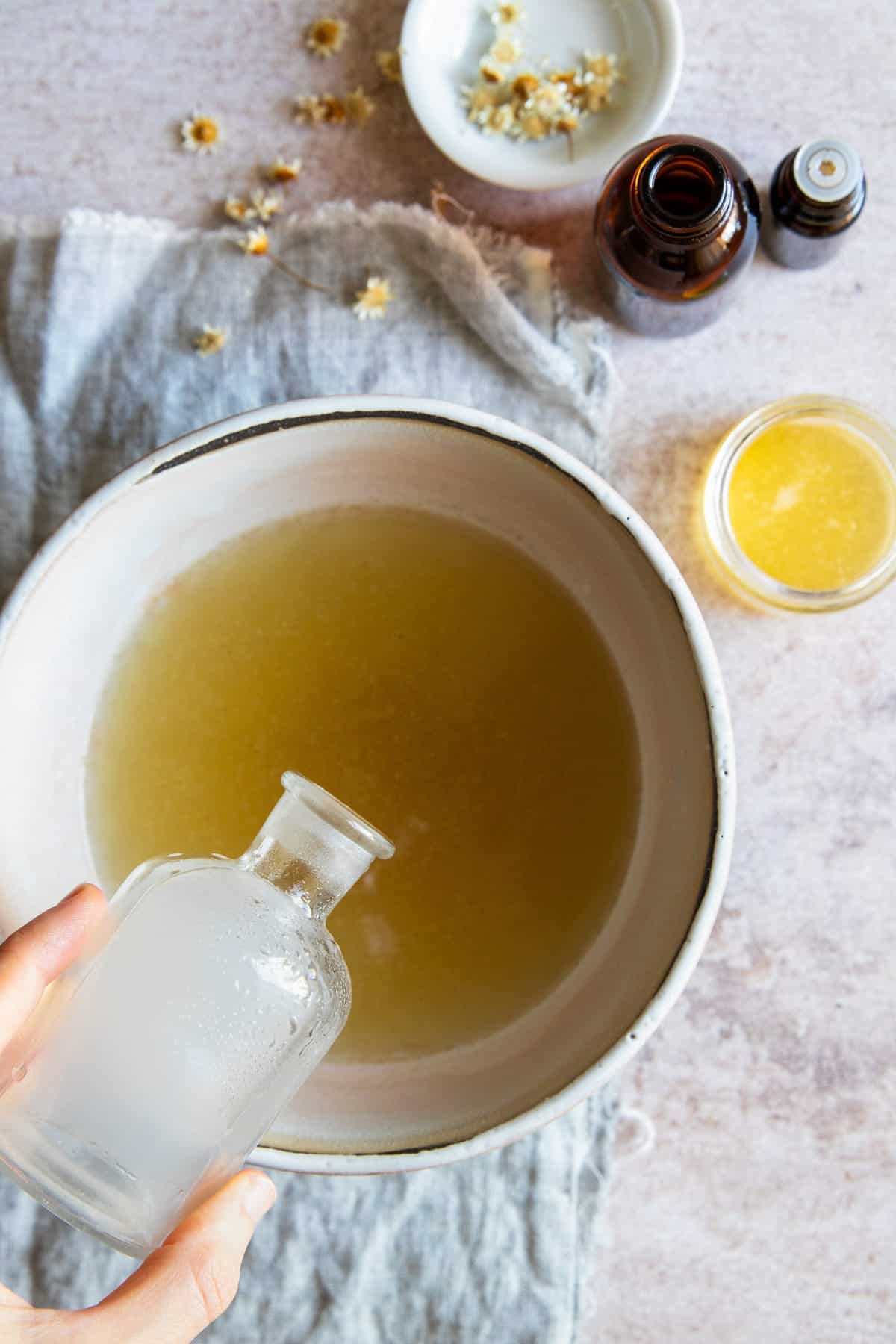
Step 2: Combine remaining ingredients
Pour the marshmallow root-infused water into a clean bowl. Add the remaining ingredients and stir well to combine.
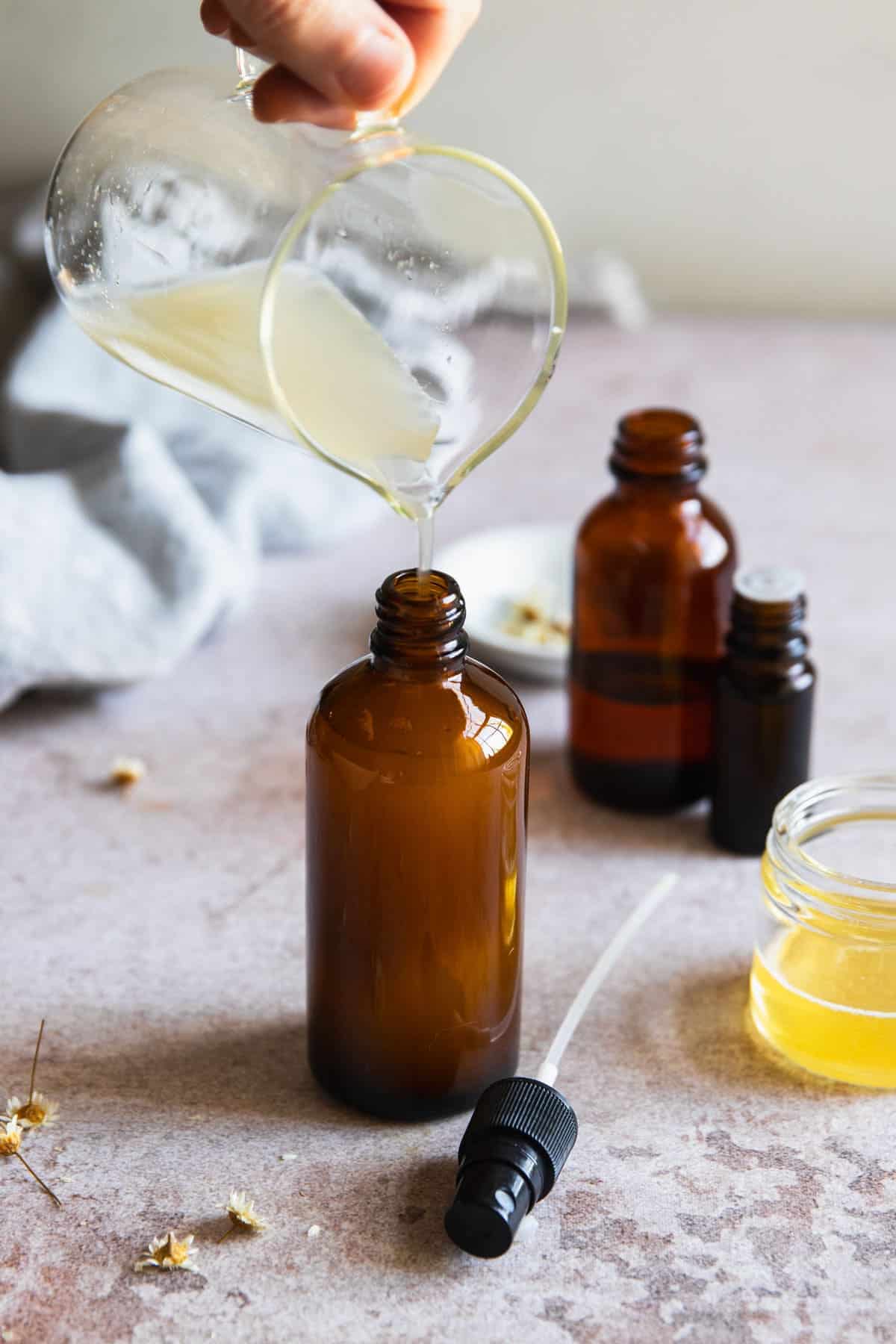
Step 3: Transfer to a spray bottle
Transfer the mixture to a spray bottle and replace the cap. Close the bottle tightly and shake well to ensure all ingredients are thoroughly mixed.
Substitutions
Honeyquat: Like honeyquat, glycerin is a humectant, which means it attracts moisture to the hair, helping to keep it hydrated and soft. Additionally, glycerin is readily available and less expensive than honeyquat, making it a convenient alternative in DIY formulations.
Bamboo Extract: Horsetail contains high levels of silica, which strengthens the hair and promotes elasticity, similar to bamboo extract.
Essential Oils for Leave-In Conditioner
Some popular choices for leave-in conditioners include
- lavender oil for its soothing properties
- rosemary oil for scalp health
- tea tree oil for its antifungal properties
- peppermint oil for a refreshing sensation
A common dilution ratio is about 1% to 2% essential oil per ounce of carrier oil or other liquid ingredients in your leave-in conditioner recipe. For example, if you have 1 ounce of carrier oil, you would add 5-10 drops of essential oil.
Leave-in Conditioner Recipe Variations
These DIY leave-in conditioner recipes are designed to provide nourishment and hydration for specific hair types. Adjust the ingredients as needed!
For Dry Hair: Coconut Milk and Aloe Vera Leave-In Conditioner
This coconut leave-in conditioner is one of my favorites. It does solidify if you keep it in the refrigerator so let it sit at room temperature for a few minutes before using.
- Mix ½ cup of coconut milk with 2 tablespoon aloe vera gel.
- Add a few drops of your favorite essential oil for hair.
- Transfer the mixture to a spray bottle and shake well before use. Apply to damp hair.
For Curly Hair: Argan and Shea Butter Leave-In Conditioner Recipe
I love shea and argan together for a deep conditioning treatment. This whipped version is heavier than other leave-in recipes so use sparingly and just apply to the ends of your hair.
- Melt 2 tablespoon shea butter in a microwave or double boiler.
- Add 1 tablespoon argan oil to the melted shea butter and stir until well combined.
- Let the mixture cool and solidify slightly.
- Use a hand mixer or whisk to whip the mixture until light and creamy.
- Take a small amount and apply it to damp or dry hair as a leave-in conditioner.
For Oily Hair: Green Tea and Honey Leave-In Conditioner
Green tea has more hair uses than you might think! Adding honey gives a bit of natural hair-lightening power.
- Steep 2 green tea bags in 1 cup of hot water for about 10 minutes.
- Remove the tea bags and let the tea cool.
- Add 1 tablespoon of honey to the cooled green tea and stir until well combined.
- Pour the mixture into a spray bottle and use it as a leave-in conditioner on damp hair.
For Normal Hair: Rosewater and Glycerin Leave-In Conditioner
Rosewater is wonderful for hair, and it adds a lovely scent. Glycerin is a non-heavy way to add moisture.
- Mix ¼ cup of rosewater with 1 tablespoon vegetable glycerin.
- Add a few drops of rose essential oil for a pleasant scent.
- Pour the mixture into a spray bottle and shake well before use. Apply to damp hair.
For Fine Hair: Apple Cider Vinegar and Water Leave-In Conditioner
This is a super light no-oil formula that won't weigh down fine or thin hair. I love apple cider vinegar rinses for cutting through buildup and adding shine, and this spray softens hair and also detangles.
- Mix 1 part apple cider vinegar with 3 parts water (e.g., ¼ cup vinegar with ¾ cup water).
- Add a few drops of your favorite hair essential oil
- Pour the mixture into a spray bottle and shake well before use. Apply to damp hair.
For Frizzy Hair: Smoothing Argan Oil and Honey Leave-In Conditioner
Argan oil is one of the best conditioning oils for your hair. It's perfect here for providing moisture, hydration, and control to help tame frizz.
- Combine ¼ cup argan oil and 1 tablespoon aloe vera gel.
- Add 3 drops jasmine essential oil for a fragrant touch if desired, and mix well.
- Transfer the mixture into a spray bottle for easy application.
- Shake well before each use and spritz onto damp hair, focusing on areas prone to frizz such as the ends and mid-lengths. Do not rinse out.
For Thinning Hair: Volumizing Rice Water and Lavender Leave-In Conditioner
Rice water is perfect for strengthening thinning hair. Just don't go overboard and use this conditioner daily; you only need it a couple of times a week.
- Mix ½ cup rice water (water strained from rinsing rice), 1 teaspoon argan oil, and 5 drops lavender essential oil in a bowl.
- Transfer the mixture to a spray bottle.
- Shake well before each use and spray onto damp hair, focusing on the roots and mid-lengths for added volume.
Storage
Store the conditioning spray in a clean, dark spray bottle or container. Amber-colored bottles are best for protecting the product from light, which can degrade certain ingredients over time.
Keep your DIY leave-in conditioner in a cool, dry place away from direct sunlight and heat, as they can cause the ingredients to degrade and reduce the effectiveness of the spray.
Your conditioning spray may last anywhere from 3-6 months. When in doubt, toss it out if you notice any changes in color, texture, or smell.
Using Homemade Leave-In Conditioner
You can use a leave-in conditioner spray every day or experiment to find the frequency that works best for you, whether it's after every wash, every other day, or just whenever your hair needs a moisture boost.
- Cleanse and towel-dry your hair: Start with freshly washed hair. Towel-dry your hair gently to remove excess water. Your hair should be damp but not dripping wet.
- Apply the spray: Hold the spray bottle about 6-8 inches away from your head and spray the leave-in conditioner evenly throughout your hair. Focus on the mid-lengths to ends, where hair tends to be driest and most damaged. You can also lightly mist your scalp if it tends to be dry or if you have specific scalp issues.
- Comb through: Use a wide-tooth comb or your fingers to gently distribute the leave-in conditioner evenly through your hair.
- Style as usual: Once the leave-in conditioner is applied and distributed, you can proceed with your usual styling routine. You can air dry your hair or use styling tools, if desired.
- Don't over-apply: Don't apply too much leave-in conditioner or you'll weigh down your hair and make it look greasy or limp. Start with a small amount and focus on the ends and drier areas.
Tip: Keep a travel-size bottle of leave-in conditioner in your bag to refresh and hydrate dry hair throughout the day. Simply mist it onto dry hair and scrunch or tousle to add moisture on the go.
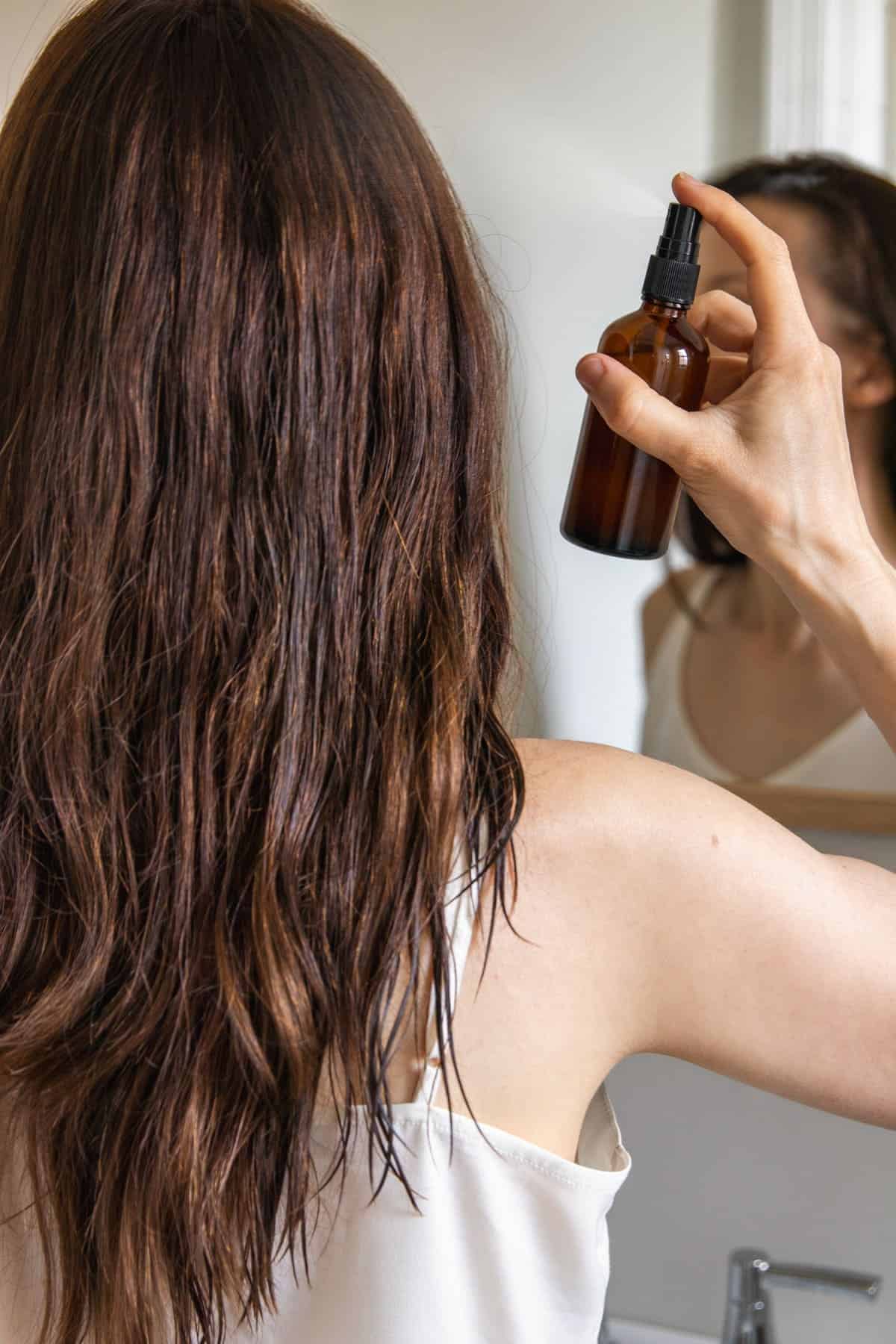
FAQ
It really depends on your hair type and its needs. Using this DIY leave-in conditioner 2-3 times a week is sufficient for most people. However, some people with very dry or damaged hair may benefit from daily use, while those with oilier hair may prefer to use it less frequently.
You should avoid using leave-in conditioner if your hair is already feeling weighed down, as it may exacerbate the issue. Additionally, if you're using styling products that don't react well with leave-in conditioner (such as certain styling gels or mousses), it's best to skip it.
While leave-in conditioner has a lot of benefits, it's not a replacement for rinse-out conditioner. Standard conditioners are formulated to deeply moisturize and nourish your hair during the washing process, whereas leave-in conditioners are designed for additional hydration, detangling, and protection after washing.
No, leave-in conditioner is meant to be left in your hair and not rinsed out. After applying it to your damp or dry hair, you can style your hair as desired without rinsing.
This DIY leave-in conditioner can be applied to both wet and dry hair, depending on your preference and hair type. For maximum absorption and distribution, many people prefer to apply it to damp hair after shampooing and conditioning. However, it can also be applied to dry hair to provide extra moisture, smoothness, and shine throughout the day.
DIY Leave-In Conditioner
Equipment
- 8 ounce spray bottle
- Glass jar or bowl
Materials
- 8 oz distilled water
- 2 tablespoons marshmallow root powder
- .5 oz bamboo extract
- .5 oz honeyquat
- 0.15 oz preservative
- 10 drops chamomile essential oil
Instructions
- Prepare the marshmallow infusion by combining the marshmallow root and water in a glass jar or bowl. Steep for 24 hours. Strain out the root using a fine mesh strainer and/or cheesecloth and set aside the liquid to use in the conditioner.
- Into large bowl, add all the ingredients and whisk well to combine.
- Transfer the liquid to an 8-ounce amber spray bottle. Replace the cap and label your leave-in conditioner with the name and date.

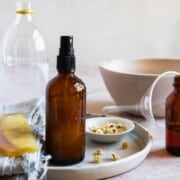



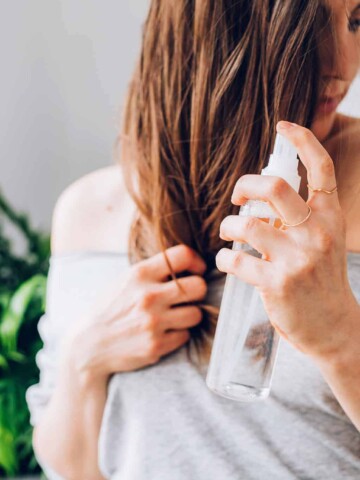
Leave a Comment